Instructions to Candidates
- Write your name and class register number in the spaces provided above.
- This paper consists of TWO sections: A and B.
- Answer ALL the questions in sections A and B in the spaces provided.
- ALL working MUST be clearly shown.
- Mathematical tables and non-programmable silent electronic calculators may be used.
QUESTIONS
SECTION A: (25 Marks)
- The figure 1 below shows a measuring cylinder with a fluid to the level shown.
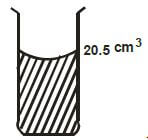
Figure 1
Find the new level when a solid of mass 13.6g and a density 1250kgm-3 is fully immersed into the cylinder. (2 marks) - A girl stands inside a lift on the second floor of an 18 storey building. If the lift is ascending upwards at an acceleration of 3ms-2 and she weighs 60kg, determine the reaction of the lift at the girl’s feet. (2mks)
- Figure 2 below represents a car hydraulic braking system.

Use the information given in the diagram above to answer questions 3(a) and 3(b).- State one property the fluid should have. (1mk)
- Explain briefly how the system operates. (3mks)
- Figure 3 below shows a machine being used to raise a load. Use the information given in the figure to answer questions 4(a) and 4(b) below
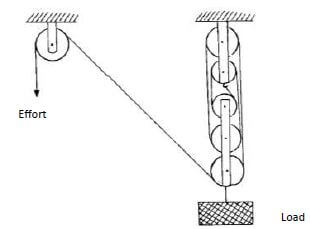
- Determine the velocity ratio (V.R) of the machine. (1mk)
- If a load of 800N is raised by applying an effort of 272N, determine the efficiency of the machine. (2mks)
- What happens to the motion of smoke particles in the smoke cell experiment when the setup is moved from an environment at 27ºc to an environment at 47ºC? (1mk)
- A uniform metre rule of mass 200g is pivoted at the 0 cm mark; calculate the force which would be applied vertically upward at the 65cm mark to keep the rule horizontal. (3mks)
- A piece of iron is heated. Explain what happens to its density. (2mks)
Figure 4 below shows two identical beakers A and B. Beaker A contains water at OºC while B contains water and pieces of ice at OºC. Both contents have the same mass.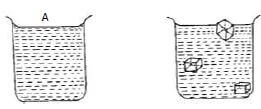
Fig. 4
Two identical metal blocks are removed from the same hot furnace and dropped into each of the beakers. Identify which of the two beakers would experience more evaporation and give a reason for your answer. (2mks) - A force of 7.5N stretches a certain spring by 5.0cm. How much work is done in stretching this spring by 8.0 cm? (2mks)
- State the Pascal’s principle of pressure transmission in fluid. (1mk)
- Figure 5 below shows a velocity time graph for a car in motion. If the mass of the car is 920kg, determine the maximum kinetic energy acquired for part of the journey shown (2mks)
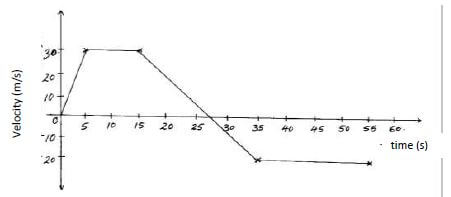
Fig. 5 - A bullet is fired horizontally at a target, neglecting air resistance, give a reason why the horizontal acceleration of the bullet is zero. (1mk)
-
- Figure 6 above shows the velocity time graph of two identical spheres released from the surfaces of two fluids A and B
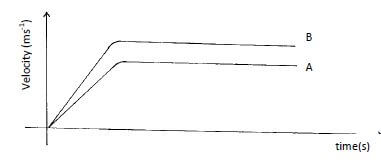
Fig. 6- State with reason, the fluid with a higher viscosity. (2mks)
- Mark on the diagram the terminal velocity on the sphere in each fluid. (1mk)
- Water flows through a horizontal pipe of varying cross-section area as shown in figure 7 below.
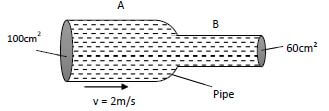
Fig. 7
The velocity of water in pipe A is 2m/s- Determine the velocity of water in pipe B. (3mks)
- State two assumptions taken in Bernoulli’s fluid flow. (2mks)
- Explain why a partially inflated balloon released at sea level would become fully inflated at a higher altitude. (2mks)
- Figure 6 above shows the velocity time graph of two identical spheres released from the surfaces of two fluids A and B
-
- State Boyle’s Law. (1mk)
- The table below shows the results from Boyle’s law experiment.
Pressure (atmospheres) 1.0 1.3 1.5 1.8 2.3 2.6 3.2 3.7 Length of air column , L(mm) 41.0 30.0 27.5 22.0 18.0 16.0 12.5 11.0 I/L x 10-2(mm)-1 - Complete the table by filling in the values for the row I/L x 10-2(mm)-1 (4mks)
- Plot a graph of pressure against I /L (5mks)
- Estimate the pressure of the air when I/L is zero. (1mk)
-
- State the Archimedes principle (1mk)
- A block of length 15cm and uniform cross section area 9cm2 is suspended from a spring balance and completely immersed in oil of density 0.8g/cm3. Given that the density of material or the block is 1.25g/cm3, determine
- The mass of the block. (3 mks)
- The reading of the spring balance (2mks)
- The reading of the spring balance if the block was half immersed in the oil. (3mks)
- With the aid if a well labelled diagram. Describe an experiment to verify the Archimedes principle. (4mks)
-
- Define the term latent heat (1mk)
- Figure 8 below shows a block of ice with two heavy weights hanging such that the copper wire / string connecting them passes over the block of ice.
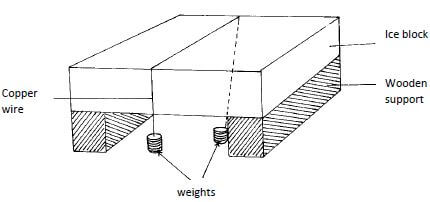
Fig. 8- It is observed that the wire gradually cuts its way through the ice block, but leaves it as one piece. Explain (3mks)
- What change would be observed if the copper wire used in the experiment was replaced by a cotton thread? Explain your answer. (2mks)
- 3kg hot water was added to 9kg of water at 10ºC and the resulting temperature was 20ºC. Ignoring heat gained by the container, determine the initial temperature of the hot water. (Specific heat capacity of water = 4200J/KgK). (3mks)
- What is the operating resistance of an electric heater rated 90W, 240V? (2mks)
- The diagram below shows a spring tied to an object, m, and rotated in a circular path of radius, r.
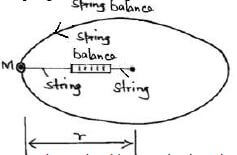
-
- What provides the force that keeps the object moving in a circular path. (1mark)
- The speed of the object is constant but the body is accelerating. Explain. (1mark)
-
- If the object is whirled faster, what would happen to spring balance reading? (1 mark)
- As the object is whirled round the string snaps and cuts off. Describe the subsequent path of the object. (1 mark)
- If the mass M of object is 500g and r is 50cm. Determine the velocity of the body if the spring balance reads 81N. (3 marks)
- Three masses are placed on a rotating turn table at distances 8cm, 10cm and 15cm respectively from the centre of rotation. When the frequency of rotation is varied it is noted that each mass slide off at a different frequency of rotation of the table as shown below.
Radius R(cm) 15 10 8 Sliding off frequency ‘’ rev/s 0.75 0.98 1.3 - State two factors that determine the frequency at which each mass slides off. (2 marks)
- The surface is made oily and then the masses are placed. Explain the changes on the frequency at which each mass slide off. (1 marks)
-
MARKING SCHEME
QN 1. V = m = 13.6 = 10.88cm3
p 1.25
New reading = 20.5+ 10.88 = 31.38cm3
QN 2. Resultant force F = Reaction – weight
F +W =R
R = ma + mg = m(a + g)
= 60 kg (10ms-2 + 3ms -2) = 780N
QN 3.
- – be incompressible
- Not corrosive
- Have low freezing point and high boiling point - The force applied on the foot pedal exerts pressure on the master cylinder .The pressure is transmitted by the brake fluid to the slave cylinder. This causes the slave cylinder to open the brake shoe and hence the brake lining presses the drum. The rotation of the wheel is thus resisted.
QN 4.
- V.R = 6
- M.A = 800 = 2.941
272
E = M.A x 100% = 2.941 x100 = 49.017 %
V.R 6
QN 5. The motion of the particles increase
QN 6. 
Clockwise moments = W x 0.5 m
Anticlockwise moment = F x 0.65m
W x 0.5 = F x 0.65
200 x 10 0.5 = F x 0.6
1000
1 = F x 0.6
0.6 0.6
F = 10 = 1.67N
6
QN7.
- Its density reduces
- Because during expansion the volume increases and its mass remains constant.
QN 8
- A
- In B some heat will be required to melt the ice hence the temperature will be slightly lower.
QN9.
7.5 N → 5cm
? → 8cm
Work done = ½ force extension
= ½ x 12 x 8/100 = 0.48 J
7.5 x 8 = 12.0 N
QN 10. Pressure applied at one point of a liquid is transmitted equally to all other parts of enclosed liquid
QN 11.
K.E = ½ MV 2
= ½ x 920 x 30 2 = 414000J
QN12. Because the horizontal force acting on the bullet is zero.
QN 13.
-
- A, has higher viscosity.
Because in fluid A a lower terminal velocity is registered due to the higher resistance of the fluid molecules to the movement of the sphere through it. 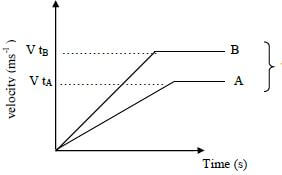
- A, has higher viscosity.
-
- A1 V1 = A2V2
100x 2 = 60 V2
V2 = 200/60 = 3.33 m/s - Liquid is non –viscous
Liquid is incompressible - As the ball rises, the atmospheric pressure on the ball reduces.
At higher altitude the pressure outside is relatively lower, thus the pressure inside the balloon exceeds the one outside causing it to become fully inflated.
- A1 V1 = A2V2
QN 14.
- The pressure of a fixed mass of a gas is inversely proportional to its volume, provided the temperature is kept constant.
-
-
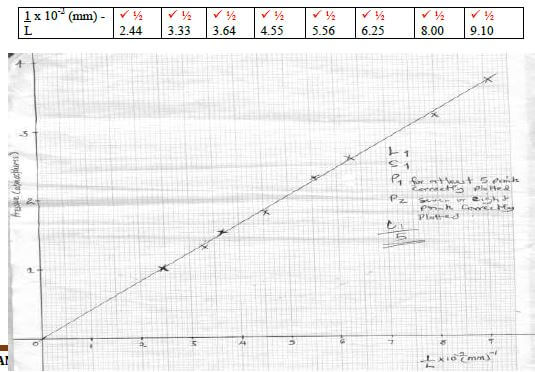
- Check graph paper
- Pressure of the air column when the length, L of air is zero
P= 0 atmospheres
-
QN 15.
- When a body is partially or totally immersed in a fluid, it experiences an upthrust equal to the weight of fluids displaced.
-

- δ= m/v Density of block
M = δ x v mass of block volume = 9 x 15 = 135cm3
= 1.25 x 135 = 168.75g = 0.16875kg - Reading - weight of oil displaced
Mass of oil displace = 135 x0.8= 108 g = 0.108kg
Weight of oil displaced = 0.108 x 10 = 1.08N
Weight = in oil = weight in air – up thrust
= 1.6 875 – 1.08 = 0.6075 N - Up thrust = weight of oil displaced
Mass of oil displaced = 67.5 x 0.8 = 54g = 0.054kg
Weight of oil displaced = 0.04 x 10 = 0.54N
Reading of balance = 1.6875 – 0.54 N
=1.1475N
- δ= m/v Density of block
- Tie an object with a string and suspend it on a s[ring balance
Use a Eureka can to check the amount of water displaced y an object when fully immersed in water.
Compare the weight of water displaced and the apparent loss in weight ( weight in air – weight in water).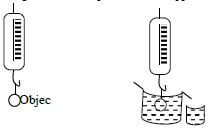
QN 16.
- The quantity of heat required to change the state of a given mass of substance without change in Temperature.
-
- Because of the hanging weights, the wire exerts pressure on the ice beneath it and therefore makes it melt at a temperature lower that its melting point. Once the ice has melted, the water formed flows over the wire and immediately solidifies since it is no longer under pressure
As it solidifies, the latent heat of fusion is released and conducted by the copper wire to melt the ice below the wire. The process continues until the wire cuts through leaving the block intact - The cotton thread would not cut through the ice at all. This is because cotton is a poor conductor of heat hence it would not conduct the latent heat of fusion released by the Solidifying ice to melt the ice below.
- Because of the hanging weights, the wire exerts pressure on the ice beneath it and therefore makes it melt at a temperature lower that its melting point. Once the ice has melted, the water formed flows over the wire and immediately solidifies since it is no longer under pressure
-
- Heat lost by hot water = Heat gained by cold water
MhCΔθ = McCΔθ2
3(θ-20)= 9 (20-10)
θ-20= 30
θ = 50º C
- Heat lost by hot water = Heat gained by cold water
- P= V2 R = V2 = 240 x 240V
R P 90 w
= 640 Ω
QN 17
-
- Tension in the spring supporting the object.
- There is change in the direction of instantaneous velocity at various points along the circular path.
-
- The spring balance reading increases.
- The object moves tangentially to the circular path at that point where it cuts.
- Reading of spring balance = Centripetal force
= MV2
V
81 = 0.5 x V2
0.5
V² = 81
V = 9msˉ¹ -
- The factors are:
Friction force
Radius
Mass of the object - Oil reduces friction force since friction provides centripetal force the frequency for sliding of is lowered.
- The factors are:
Download Physics Paper 1 Questions and Answers - Lanjet Joint Mock Exams 2022.
Tap Here to Download for 50/-
Get on WhatsApp for 50/-
Why download?
- ✔ To read offline at any time.
- ✔ To Print at your convenience
- ✔ Share Easily with Friends / Students
